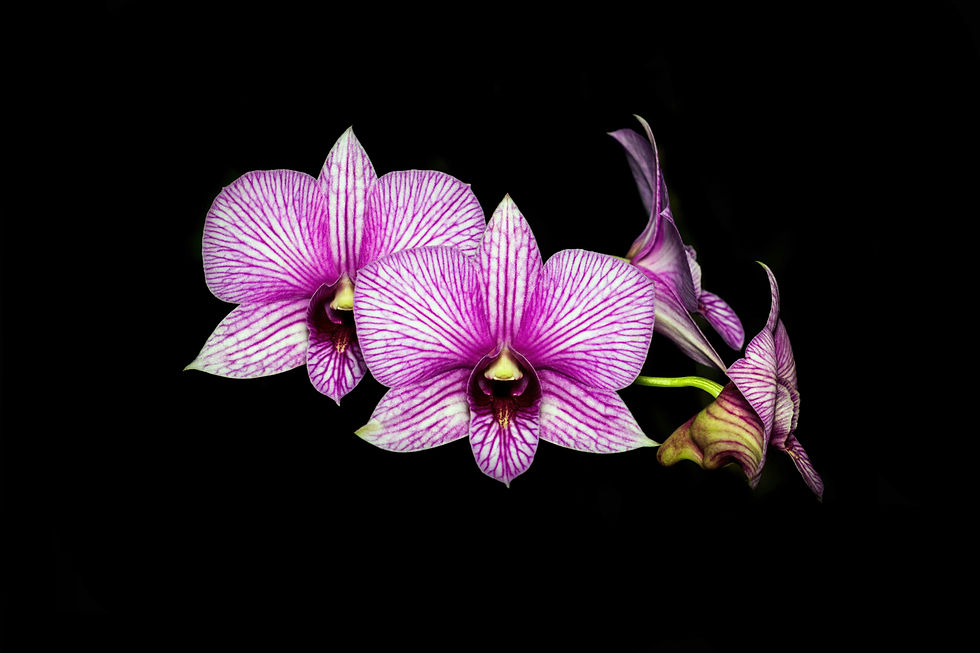How to Encourage Orchids to Bloom Beautifully
- Guna Orchids

- Apr 6
- 4 min read
Orchids are one of the most beautiful plants you can cultivate, known for their stunning flowers and exotic appearance. However, getting them to bloom beautifully can sometimes feel like a daunting task. With the right care and a bit of know-how, you can encourage your orchids to showcase their vibrant colors and intricate shapes. In this guide, we will explore the essential steps you can take to ensure your orchids thrive and bloom to their full potential.
Understanding Blooming Orchids
To successfully grow blooming orchids, it’s important to know the different types. There are numerous varieties, such as Phalaenopsis, Cattleya, and Dendrobium, each with its specific needs regarding light, water, and humidity. Understanding what your particular orchid species requires can make a significant difference in its growth.
For example, Phalaenopsis orchids thrive in low to medium light and need a little more water than other types. Alternatively, Cattleya orchids prefer bright, indirect sunlight and can withstand slight dryness between watering. Knowing your orchid's specific requirements is the first step to fostering blooms.

Key Factors to Encourage Blooming Orchids
1. Light Requirements
Proper lighting is crucial for orchid blooming. Most orchids prefer bright, indirect sunlight. If you notice your orchid leaning towards the light source, it may not be receiving enough light. Conversely, if the leaves are turning yellow or scorched, it may be too bright.
A good rule of thumb is to place your orchids near east or west-facing windows, where they can receive filtered sunlight. If natural lighting is insufficient, consider using grow lights to ensure your orchids get at least 12-14 hours of light daily.
2. Watering Techniques
Overwatering is a common mistake among orchid growers. It is essential to allow the roots to dry out between waterings. Generally, orchids should be watered every 7-10 days, but this can fluctuate based on your climate and the specific needs of your orchid.
To check if your orchid needs water, feel the potting medium. If it feels dry to the touch about an inch below the surface, it’s time to water. Make sure to thoroughly water the plant, allowing excess to drain out of the pot.

What Does the Blooming Orchid Mean?
In many cultures, orchids symbolize beauty, strength, and luxury. They are often seen as a representation of love and thoughtfulness as well. The blooming orchid signifies a sense of refinement and rarity. Many believe that when orchids bloom, it is a good omen of prosperity and joy.
Moreover, the variety of colors orchids come in each has its specific meanings. For instance, a pink orchid is often associated with love and admiration, while a white orchid can symbolize purity and elegance. Understanding these meanings adds an extra layer of appreciation to caring for your blooming orchids.
3. Feeding and Fertilization
Regular feeding is vital for orchids to grow healthy and bloom. A balanced, water-soluble fertilizer every two weeks is recommended during the growing season (spring to fall). During the rest period in winter, you can cut back on feeding to once a month.
When applying fertilizer, always dilute it according to the package instructions. Over-fertilization can harm your orchids and may prevent blooming altogether. Look for a fertilizer specifically formulated for orchids, as it typically includes essential minerals that are beneficial to their growth.
4. Humidity and Temperature Control
Orchids thrive in humid environments, typically between 40%-70% humidity. If you live in a drier climate, consider using a humidity tray or a room humidifier to maintain an optimal level for your plants.
Temperature also plays a critical role in orchid blooming. Most orchids prefer a daytime temperature ranging from 65°F to 75°F (18°C to 24°C) and a slight drop at night. Ensure that your orchids are not placed in drafty areas to avoid temperature fluctuations that could stress them out.
5. Potting and Repotting
When it comes to potting your orchids, the right medium is essential. Orchids do not grow in soil; they need a well-draining medium. A combination of bark, sphagnum moss, and perlite creates an excellent environment that mimics their natural habitat.
Repotting is also important, especially if you notice that the roots are growing out of the pot or if the potting medium has broken down. Repot every 1-2 years in fresh medium to keep your orchids healthy.

Final Thoughts on Cultivating Blooming Orchids
Caring for orchids requires patience and attention, but the rewards are undeniably beautiful. By understanding the specific needs of your orchids and implementing the tips outlined in this post, you can encourage them to blossom beautifully.
Whether you are a seasoned orchid enthusiast or just starting, remember that every orchid has its unique personality and care needs. Enjoy the journey of nurturing your plants and revel in the beauty when they finally bloom!
For more in-depth guidance on the specifics of care and to see a beautiful palette of accessories to support your journey, check out the resource for blooming orchids. Happy gardening!



Comments